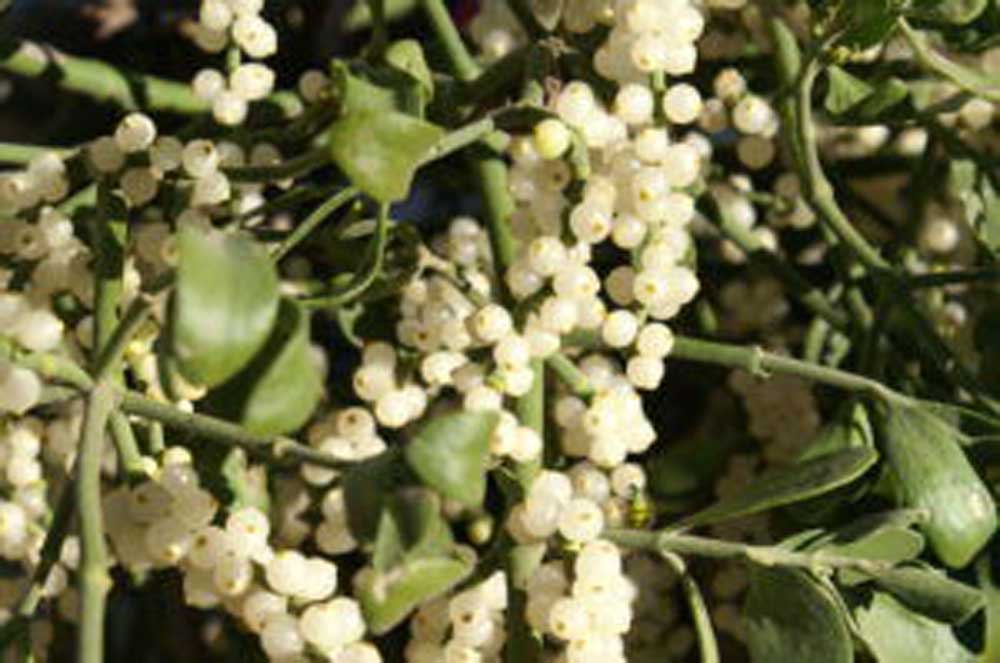Mistletoe
Published 3:42 pm Wednesday, December 8, 2021

- There are more than a thousand different types of mistletoe, and the plants grow all over the world in a variety of climates, including the desert.
Mistletoe is a semi-parasitic plant that produces small white berries and grows almost exclusively in trees. The word mistletoe comes from the Old English misteltan. Mistletoe can be spread through birds’ feces, hence it is possible that mistel derives from an obsolete, Germanic-derived noun mix, meaning “dung, filth,” with tan meaning “twig.” Which is really weird since most people associate mistletoe with kissing and festive holiday gatherings, you probably don’t want to know the etymology of the plant’s name!
There are more than a thousand different types of mistletoe, and the plants grow all over the world in a variety of climates, including the desert. European mistletoe has smooth-edged, oval evergreen leaves borne in pairs along the woody stem and waxy, white berries that it bears in clusters of two to six. The Eastern mistletoe of North America is similar, but has shorter, broader leaves and longer clusters of 10 or more berries.
Mistletoe reproduces by seeds, but has evolved special adaptations to keep its seeds from falling to the ground, where they would be unable to sprout and develop into a mature plant. If you squeeze open the whitish semi-translucent berries you’ll find that the seeds are very sticky. They are covered with a glue-like substance called viscin, so they stick to whatever they fall on. They mostly fall on branches high up in trees because the berries are a favorite wintertime snack for birds, who then excrete the seeds where they roost.
Once the excrement falls and sticks to the tree branch, the plant seeds it tiny roots into the bark’s cambium layer, where it siphons off water and nutrients, slowly weakening the tree. A mature tree can withstand a small amount of mistletoe with no problem, but if it spreads profusely the tree will eventually die, one limb at a time, as the life is literally sucked out of it. However, mistletoe doesn’t take out whole forests like some diseases do — just a tree here and a tree there. Ecologists view it as an important part of a healthy ecosystem, because the berries are a major food source for birds, who also find the dense foliage great for nesting and the dead trees became acquisitions for raptors.
Kissing under mistletoe is a well-known holiday tradition, but this plant’s history as a symbolic herb dates back thousands of years. The Greeks were known to use it as a cure for everything from menstrual cramps to spleen disorders, and the Roman naturalist Pliny the Elder noted it could be used as a balm against epilepsy, ulcers and poisons. The plant’s romantic overtones most likely started with the Celtic Druids of the 1st century A.D. Because mistletoe could blossom even during the frozen winter, the Druids can to view it as a sacred symbol of vivacity, and the administered to humans and animals in hope to restore fertility.
Just how it made the jump from sacred herb to holiday decoration remains up for debate, but the kissing tradition appears to have first caught on among servants in England before spreading to the middle classes. As part of the early custom, men were allowed to steal a kiss from any woman cause standing under the mistletoe, and refusing was viewed as bad luck. Yet another tradition instruct the merrymakers to pluck a single berry from the mistletoe with each kiss, and to stop smooching once they were all gone!
So there you have it, let the holiday smooching begin!!






